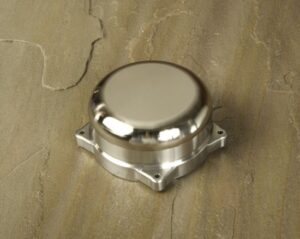

Bulk Destruct Charge Assemblies (DCAs)
A Destruct Charge Assembly (DCA) is an explosive charge used in a Flight Termination System (FTS) to render a missile or launch vehicle non-propulsive and non-aerodynamic. EBAD has designed, qualified, and manufactured Destruct Charge Assemblies for more than 50 years and has a large catalog of fielded Linear Shaped Charge (LSC), Conical Shaped Charge (CSC), and Bulk Destruct Charge Assemblies (DCA).
Principle of Operation
 DCAs are detonating devices, so must be actuated with a detonating initiator. Common detonation inputs to EBAD’s DCAs are Flexible Confined Detonating Cord Assembly (FCDCA), Low Energy Exploding Foil Initiator (LEEFI), or similar electric or non-electric detonation transfer components. Once initiated, the DCA explosive material rapidly detonates, driving a metal flyer plate into a solid rocket motor or liquid fuel tank, penetrating the target and rendering the motor non-propulsive, and severing the missile or launch vehicle skin.
DCAs are detonating devices, so must be actuated with a detonating initiator. Common detonation inputs to EBAD’s DCAs are Flexible Confined Detonating Cord Assembly (FCDCA), Low Energy Exploding Foil Initiator (LEEFI), or similar electric or non-electric detonation transfer components. Once initiated, the DCA explosive material rapidly detonates, driving a metal flyer plate into a solid rocket motor or liquid fuel tank, penetrating the target and rendering the motor non-propulsive, and severing the missile or launch vehicle skin.
Construction
The DCA consists of a stainless-steel housing that contains the explosive materials and two or more ports for initiation inputs such as EBAD’s FCDCA explosive transfer line or other detonation input device. The housing has built-in flyer plates that form penetrating projectiles upon initiation and detonation. The overall assembly is robust to climatic and dynamic environments and hermetically sealed. DCAs use MIL-STD-1316 compliant secondary explosive materials.
Applications
EBAD DCAs are flight proven in Flight Termination Systems for many Tactical Missile and Launch Vehicles and have been qualified to extreme environments for FTS applications. Our DCA offering are often used in conjunction with our RCC-319 qualified Electronic or Electro-Mechanical Safe & Arms, FCDCA explosive transfer lines, Lanyard Pull Initiators (LPI), and other FTS equipment. EBAD is as a trusted partner for delivery of a FTS architecture, from Range Safety tailoring, modeling, prototyping, and validating initial designs, through qualification and delivery of FTS hardware.
Key Features
-
- Qualified to RCC-319-14 and other heritage Range Safety standards.
- MIL-STD-1316 compliant explosive materials
- Used on multiple US and European ranges
- FCDCA, LEEFI, and other initiation methods
- Rugged construction
- Easy mounting
- High dynamic and thermal environment capability
- Rapid development, prototyping, and penetration testing for design verification

